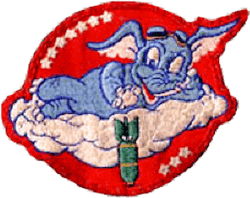873d Tactical Missile Squadron
| 873d Tactical Missile Squadron | |
|---|---|
 Emblem of the World War II 873rd Bombardment Squadron | |
| Active | 1943-1946; 1961-1969 |
| Country | United States |
| Branch | United States Air Force |
| Type | Bombardment/Tactical Missile |
The 873d Tactical Missile Squadron is an inactive United States Air Force unit. Its last assignment was with 498th Tactical Missile Group stationed at Kadena Air Base, Okinawa.
History
B-29 Superfortress operations against Japan
Activated in November 1943 as one of the initial B-29 Superfortress Very Heavy bombardment squadrons. Trained in Kansas with early model B-29s, with frequent delays in training due to modifications of the aircraft correcting production deficiencies.
When training was completed moved to Isely Field, Saipan, in the Mariana Islands of the Central Pacific Area in January 1945 and assigned to XXI Bomber Command, Twentieth Air Force. As the first B-29 squadron in the Marianas (15 aircraft assigned), its mission was the strategic bombardment of the Japanese Home Islands and the destruction of its war-making capability.
Flew "shakedown" missions against Japanese targets on Moen Island, Truk, and other points in the Carolines and Marianas. The squadron conducted combat missions over Japan participating in wide area firebombing attacks, but the first ten-day blitz resulting in the Army Air Forces running out of incendiary bombs. Until then the squadron flew conventional strategic bombing missions using high explosive bombs.
The squadron continued attacking urban areas with incendiary raids until the end of the war in August 1945, attacking major Japanese cities, causing massive destruction of urbanized areas. Also conducted raids against strategic objectives, bombing aircraft factories, chemical plants, oil refineries, and other targets in Japan. The squadron flew its last combat missions on 14 August when hostilities ended. Afterwards, its B 29s carried relief supplies to Allied prisoner of war camps in Japan and Manchuria
Squadron was largely de-mobilized on Saipan during the fall of 1945. Was reorganized as part of continental Air Forces, Fourth Air Force at March Field, California in November 1945, being manned and equipped with low-hour B-29s returned from the Central Pacific. It later was transferred to the new Strategic Air Command on 21 March 1946, being one of SAC's initial bombardment squadrons. Demobilization, however, was in full swing and the unit turned in its aircraft and was inactivated on 31 March 1946.
United States Air Force
Reactivated in 1961 as a MGM-13 Mace Surface to Surface Missile squadron in Okinawa.
The four 873 TMS Mace sites were located at Bolo Point in Yomitan, Onna Point, White Beach, and in Kin just north of Camp Hansen.[1][2] One of the dismantled Mace sites now houses a Buddhist training center for Soka Gakkai International. The facility is now known as the "Fortress of Peace" and houses two museums including one devoted to the nuclear weapons once based on Okinawa.
The 873rd TMS was inactivated with the phaseout of the weapon in 1969.
Operations and decorations
- Combat Operations: Combat in Western Pacific, 28 Oct 1944-14 Aug 1945.
- Campaigns: Air Offensive, Japan; Eastern Mandates; Western Pacific.
- Decorations: Distinguished Unit Citations: Japan, 13 Dec 1944; Japan, 1-7 Jun 1945. Air Force Outstanding Unit Award: 8 Feb 1961-29 May 1963.
Lineage
- Constituted 873d Bombardment Squadron on 19 November 1943
- Activated on 20 November 1943
- Inactivated on 4 August 1946
- Redesignated 873d Tactical Missile Squadron, and activated, on 25 April 1961
- Organized on 8 September 1961
- Inactivated on 8 July 1969
Assignments
- 498th Bombardment Group, 20 November 1943 – 4 August 1946
- Pacific Air Forces, 25 April 1961
- 498th Tactical Missile Group, 8 September 1961 – 8 July 1969
Stations
|
|
Aircraft and Missiles
- B-17 Flying Fortress, 1944
- B-29 Superfortress, 1944–1946
- MGM-13 Mace, 1961–1969
See also
References
![]()
- ↑ Mitchell, Jon (July 8, 2012). "Okinawa's first nuclear missile men break silence". The Japan Times. Retrieved September 4, 2012.
- ↑ George Mindling; Robert Bolton (1 October 2008). U. S. Air Force Tactical Missiles. Lulu.com. pp. 215–. ISBN 978-0-557-00029-6. Retrieved 23 April 2013.
- Maurer, Maurer, ed. (1983) [1961]. Air Force Combat Units of World War II (PDF) (reprint ed.). Washington, DC: Office of Air Force History. ISBN 0-912799-02-1. LCCN 61060979.
- Maurer, Maurer, ed. (1982) [1969]. Combat Squadrons of the Air Force, World War II (PDF) (reprint ed.). Washington, DC: Office of Air Force History. ISBN 0-405-12194-6. LCCN 70605402. OCLC 72556.
.png)